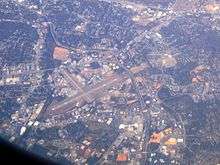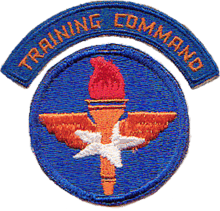Greenville Downtown Airport
Greenville Downtown Airport (IATA: GMU, ICAO: KGMU, FAA LID: GMU) is three miles east of Greenville, in Greenville County, South Carolina, United States. It is owned by the Greenville Airport Commission and is the busiest general aviation airport in South Carolina.[1]
Greenville Downtown Airport (Greenville Municipal Airport) | |||||||||||||||
|---|---|---|---|---|---|---|---|---|---|---|---|---|---|---|---|
 | |||||||||||||||
| Summary | |||||||||||||||
| Airport type | Public | ||||||||||||||
| Owner | Greenville Airport Commission | ||||||||||||||
| Serves | Greenville, South Carolina | ||||||||||||||
| Elevation AMSL | 1,048 ft / 319 m | ||||||||||||||
| Coordinates | 34°50′53″N 082°21′00″W | ||||||||||||||
| Map | |||||||||||||||
 GMU Location in South Carolina | |||||||||||||||
| Runways | |||||||||||||||
| |||||||||||||||
| Helipads | |||||||||||||||
| |||||||||||||||
| Statistics (2016) | |||||||||||||||
| |||||||||||||||
The National Plan of Integrated Airport Systems for 2011–2015 categorized it as a general aviation facility.[2]
History

GMU opened in 1928 as Greenville Municipal Airport. In 1930 it received its first airmail flight. Amelia Earhart flew demonstration flights at GMU in an Autogiro for the Beech-Nut Company in November 1931. Eastern Airlines began scheduled flights in the late 1930s and Delta Airlines arrived in 1945.
During World War II the United States Army Air Forces used the airfield for training. The airport was used jointly by the Army Air Forces Flying Training Command, Southeast Training Center (later Eastern Flying Training Command) as a contract glider training school, operated by Southern Airways, Inc. The 19th AAF Glider Training Detachment was a Basic training school active from September 1942 until March 1943 using Aeronca TG-5 and Laister-Kauffmann TG-4A training gliders. The airport was then reassigned to Air Technical Service Command and used as a supply and maintenance depot until being returned to full civil control in October 1945.
Until 1962 GMU (then GRL) was the commercial airport for the Greenville area; in April 1957 it had 13 weekday departures on Eastern, four on Delta and four on Southern. Eastern had one nonstop to Richmond, but no other nonstops out of Greenville exceeded 200 miles.
Commercial service moved to Greenville-Spartanburg Airport when it opened October 15, 1962.
It was from this airport that the fatal flight of the Lynyrd Skynyrd Convair 240 departed on October 20, 1977 (by this time named Greenville Downtown Airport).
The recently renovated terminal won a national award.
Facilities
Greenville Downtown Airport covers 385 acres (156 ha) at an elevation of 1,048 feet (319 m). It has two asphalt runways: 1/19 is 5,393 by 100 feet (1,644 x 30 m) and 10/28 is 3,998 by 80 feet (1,219 x 24 m). It has two helipads, each concrete 50 by 50 feet (15 x 15 m).[1]
The Airport Commission recently completed extensive runway, taxiway, and apron improvements, a major terminal renovation, and construction of a new road that made additional land available for development.
Located at GMU are many companies that provide aviation services like aircraft rental, flight instruction, aircraft maintenance, helicopter services, aircraft management, fuel service, aircraft sales, air charter and air taxi.
GMU has a restaurant, the Runway Cafe, and a public park where people can learn about aviation.[3]
In 2016, the airport had 91,612 aircraft operations, average 412 per day: 65% general aviation, 32% air taxi, and 3% military. 410 aircraft are based at this airport.
Governance
The Greenville Downtown Airport is governed by a five-person appointed Commission authorized by Act 919. Two appointees each from city and county councils, and one at-large, serve three-year terms.
Economic impact
The South Carolina Statewide Aviation System Plan & Economic Impact Report released in 2018 concluded that in 2017 the Greenville Downtown Airport (GMU) had a significant annual economic impact on the state of South Carolina and our local region. They determined that GMU had the following direct and indirect/induced economic impact:
- Employment: 547
- Payroll: $24.9 million
- Economic activity: $68.8 million
Air traffic
GMU's air traffic is heavier than all other general aviation airports, topped by only three commercial airports (Myrtle Beach International, Charleston International/Air Force Base and Columbia Metropolitan) in South Carolina.[4]
Based aircraft
GMU has more based aircraft than any other airport in South Carolina.[5]
Awards
The FAA Southern Region selected GMU to receive its General Aviation Airport Safety Award. The award is presented to a general aviation airport in the Southeast that makes outstanding efforts to increase flight safety. GMU accomplished this by completing numerous safety-enhancing projects. Of particular note, GMU was the first general aviation airport in the nation to install an Engineered Material Arresting System (EMAS) in the latter part of 2003. EMAS rapidly and safely decelerates aircraft that have overrun the active runway by utilizing energy absorbing material. In the summer of 2006, this system was credited with saving five passengers and a $20 million Falcon 900 jet that overran Runway 1 due to a brake malfunction.
The FAA Southern Region selected Joe Frasher, Airport Director of GMU, as the 2008 General Aviation Airport Manager of the Year. This award is presented to a general aviation airport manager in the Southeast who makes outstanding efforts to increase flight safety. Frasher had been instrumental in completing numerous safety-enhancing projects at GMU over the previous 26 years.
"The staff of the Greenville Downtown Airport is distinguished in its commitment to continually increasing flight safety," said Rusty Chapman, recently retired Manager of the Airports Division, FAA Southern Region. "They accomplished a significant number of safety upgrades while still successfully operating the state's busiest general aviation airport."
The award was presented to Frasher at the 2009 FAA Communications Conference in Atlanta on January 30, 2009.
See also
- South Carolina World War II Army Airfields
- 29th Flying Training Wing (World War II)
- List of airports in South Carolina
References
- FAA Airport Master Record for GMU (Form 5010 PDF). Federal Aviation Administration. Effective November 15, 2012.
- "2011–2015 NPIAS Report, Appendix A" (PDF). National Plan of Integrated Airport Systems]. Federal Aviation Administration. October 4, 2010. Archived from the original (PDF, 2.03 MB) on October 27, 2012.
- http://www.greenvilledowntownairport.com/RunwayParkatGMU.html
- http://www.scaeronautics.com/reports/RPTOPERATIONS70336204.Pdf
- http://www.scaeronautics.com/reports/RPTBASEDPLANES43373508.Pdf

| Wikimedia Commons has media related to Greenville Downtown Airport. |
- Shaw, Frederick J. (2004), Locating Air Force Base Sites History’s Legacy, Air Force History and Museums Program, United States Air Force, Washington DC, 2004.
- Manning, Thomas A. (2005), History of Air Education and Training Command, 1942–2002. Office of History and Research, Headquarters, AETC, Randolph AFB, Texas ASIN: B000NYX3PC
External links
- Greenville Downtown Airport
- FAA Airport Diagram (PDF), effective August 13, 2020
- FAA Terminal Procedures for GMU, effective August 13, 2020
- Resources for this airport:
- FAA airport information for GMU
- AirNav airport information for KGMU
- ASN accident history for GMU
- FlightAware airport information and live flight tracker
- NOAA/NWS weather observations: current, past three days
- SkyVector aeronautical chart, Terminal Procedures
